Wind Energy
The process of using the wind to generate mechanical power or electricity is known as wind power or wind energy. Wind turbines transform the wind's kinetic energy into mechanical energy. This mechanical energy can be employed for specialized operations (such as grain grinding or water pumping) or transformed into electricity by a generator.

During this project we learned a lot about the importance of building materials. They have a big impact on the buildings but also on the environment. By using building materials like rammed earth we can safe masses of energy for other things.
We also realised how difficult it is to make environmentally friendly adjustments, as there are many individual variables in a building project.
Even though we didn't expect the complexity of this project, we managed to put together an informative project.
By Dario & Justin
At first we didn't have a good project idea, but later we quickly found a topic (tree diseases and neophytes).
We searched up a lot of information and made pictures. Kevin had even conducted an interview and I created a survey for the teams from abroad.
Unfortunately, no one filled out the survey and it was a little difficult for the people from our class to understand.
We realized before our IDAF presentation that our topic was too big. We then limited ourselves to the neophytes because the topic is very current.
I then came across the topic of guerrilla gardeners and we then conducted an interview with one of the first guerrilla gardeners in Switzerland.
We learned a lot about neophytes and we hope that our contribution on DWME will bring the topic closer to others.
Kevin and Tamara
Our goals (12.01.2021):
- finish text production
- think about a good head image
- talk with Ms. Sutter
Kevin and Tamara
If we are completly honest we had a lot of ups and downs during our project 'living vegan in the city'.
First, we had trouble finding a project we liked and that had something to do with the subject "city climat & city trees". Ms Sutter has told us to lay our focus on urban gardening but unfortunately an other team already had this subject, so we had to find a way around the others. When we finally had our subject "living vegan in the city" combined with urban gardening we were very happy.
We had a lot of fun creating the survey and analizing it. Also the interview with Carmen's aunt was very informative and exciting.
Unfortunately the colaboration with the teams from Antwerp didn't work out like we wanted, because theyr teacher never responded to our mail.
In the end I think Carmen and I were successfull because we learned new things about urban gardening and we had fun working at the project.
We decided to answer the question "How many trees does a city like Zurich need to offset its CO2 emissions?
We wanted to analyse this question with research and a subsequent calculation, and to get the opinion of the people with a survey.

Areas in Zurich:
9032 hectares (2018) --> 90.32 square kilometres
- Agricultural area 9.5%
- Forest area 26.4%
- Traffic area 14.6%
- Settlement area 47.7%
- Area of water bodies 1.2%
- Unproductive area 0.6%
Motor vehicle fleet:
- Passenger cars: 134'713
- Motorbikes: 23'581
Drive type:
- petrol engine: 63.7%
- diesel engine: 31.5%
- hybrid: 3.2%
- electric motor: 1.1%
- other: 0.5%
Electricity origin Zurich:
- Refuse and wood 1.65%
- Photovoltaics / Wind 1.27%
- Hydropower 24.9 %
- Nuclear power 6.69%
- Electricity mix 9.11%
- Paraffin 10.98%
- Diesel 8.83%
- Petrol 3.79%
- Wood, biogas & environmental heat and solar collectors 2.64%
- District heating 3.3%
- Natural gas 17.75%
- Fuel oil 9.09%
CO2 emissions:
CO2 emissions per capita 1.31 tonnes per year
City of Zurich Population: 415,467
= 544,261.77 tonnes of emissions caused by persons
CO2 emissions of companies in Zurich: 355738.23
Number of companies in Zurich: 6,037
= 58.93 tonnes on average per company
900,000 tonnes of CO2 per year in the city of Zurich

400 planes per day (June 2019)
134713 cars + 23581 motorbikes (June 2019)
10991 trains on Swiss tracks --> thereof in Zurich 1100
https://www.zuerich-co2.ch/
Trees:
80 trees for 1 ton of CO2 per year
Beech and chestnut trees convert twice as much on average
23,681,619 M2 forest area in Zurich
1 tree per M2
=23'681'619 trees in the forest

Review and evaluation of what has been done and what remains to be done
We have drawn up a plan to realise everything we want to achieve
All in all, we hardly had any problems. The only thing that can be a thorn in our side is the coronary gland, which makes the survey and interview difficult.
We try to stick to the plan and work through everything step by step.
This week we will contact Andrea Gion Saluz to organize an interview. Maybe this will help us enormously in the other things
Laurice & Michael
-Analyse the response of our expert
-Read the documents he's sent us and evaluate what we can use for our project.
Pamphlets_Home Composting.pdf (216,59 kb)
Thank you for checking it out!
Ulza & Chantal
Hello everybody,
We are looking for someone who would do a collaboration with our project.
Our project is about changing the future. We want to see how our environment would change if everyone would only drive electric cars in the cities. We have already done several interviews, but we still want opinions that are not in the same country. We want to know what people think who live in a different country, where the circumstances are also different than in Switzerland.
We are also working on a survey to obtain several opinions.
We would be interested to hear other opinions.
Nils and Dylan
